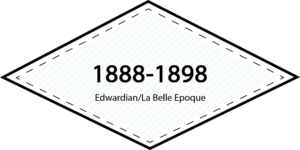
“Naughty Nineties”
Strong women in a fast-paced world of work & play


—— THE ERA IN BRIEF ——
Science merged with fashion & everything was bigger in the ’90’s: bustles the size of horses, busts that threw one off balance, clouds of hair, & ideas that would change the world. It seemed powerful women needed BIG sleeves & tiny waists to succeed. Men & women were equal in that no one could figure out how to use the new-fangled contraptions that were being invented every day. Fast cars, tea parties, & fluffy afternoons in the park were the norm for some, while others spent their time in business meetings or riding a “Bicycle Built for Two”. The world was changing fast towards the new century when women would leave their subservient roles & their large bu-stles behind.
 —— PORTRAITS OF REAL WOMEN FROM THE ERA ——
—— PORTRAITS OF REAL WOMEN FROM THE ERA ——
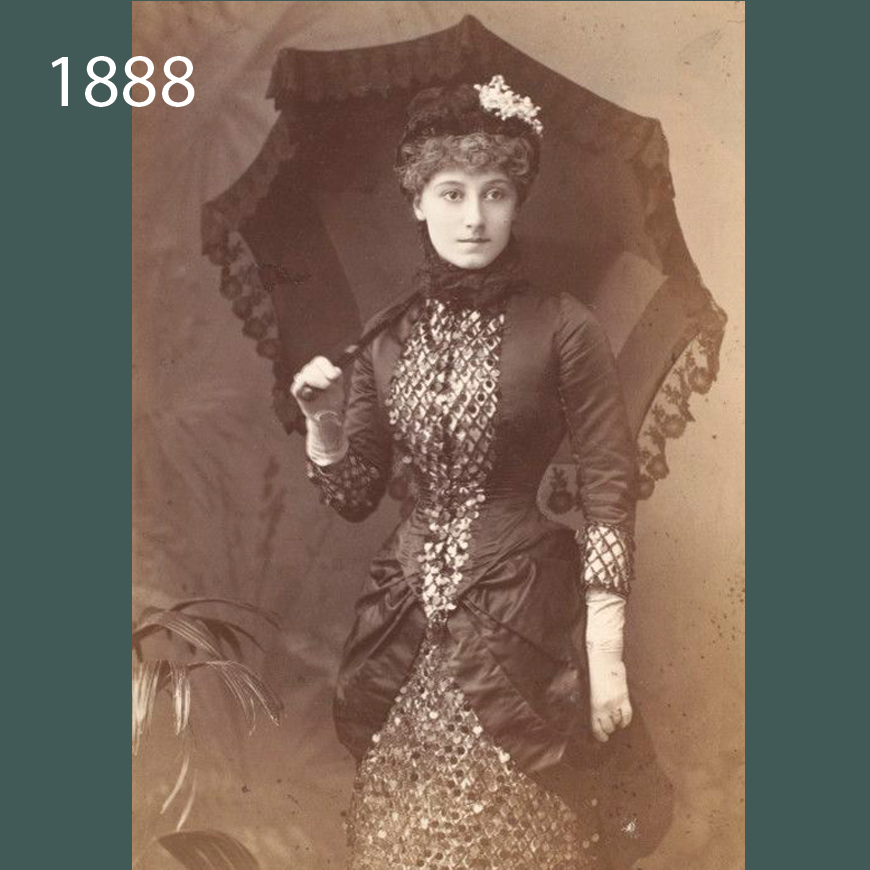
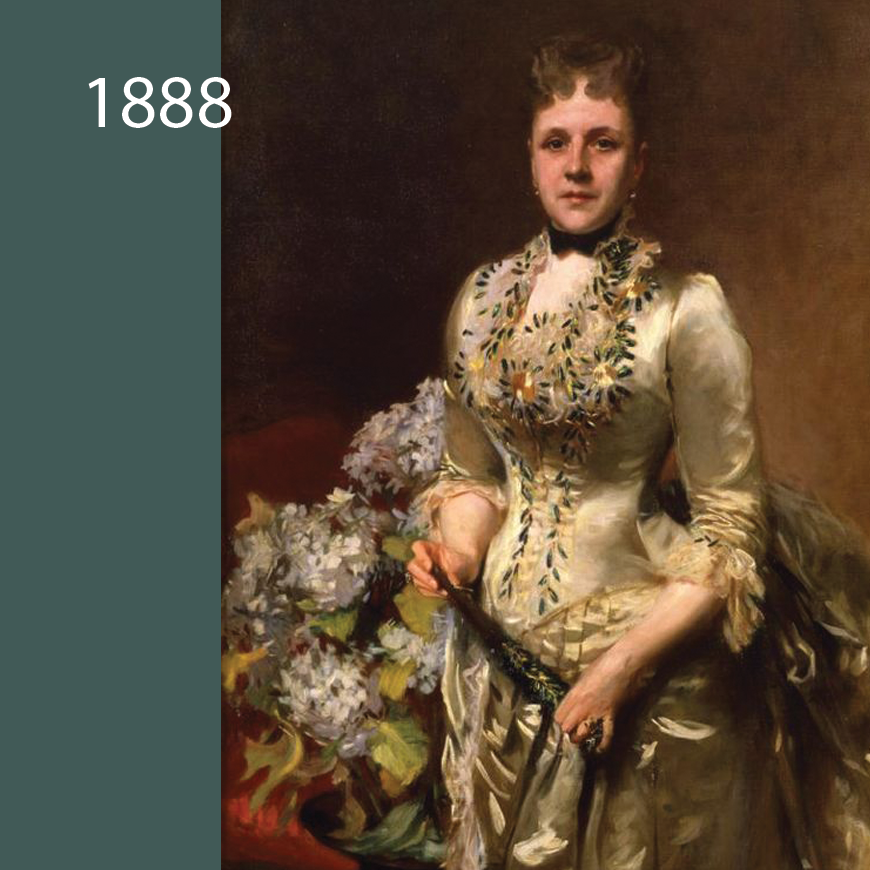
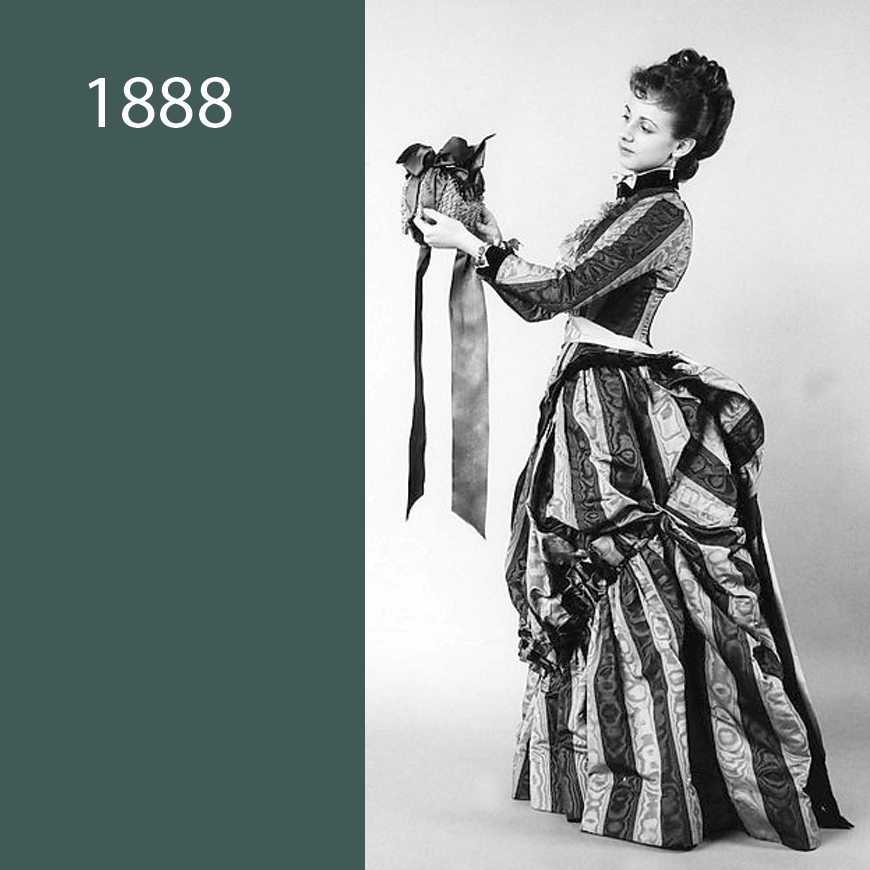
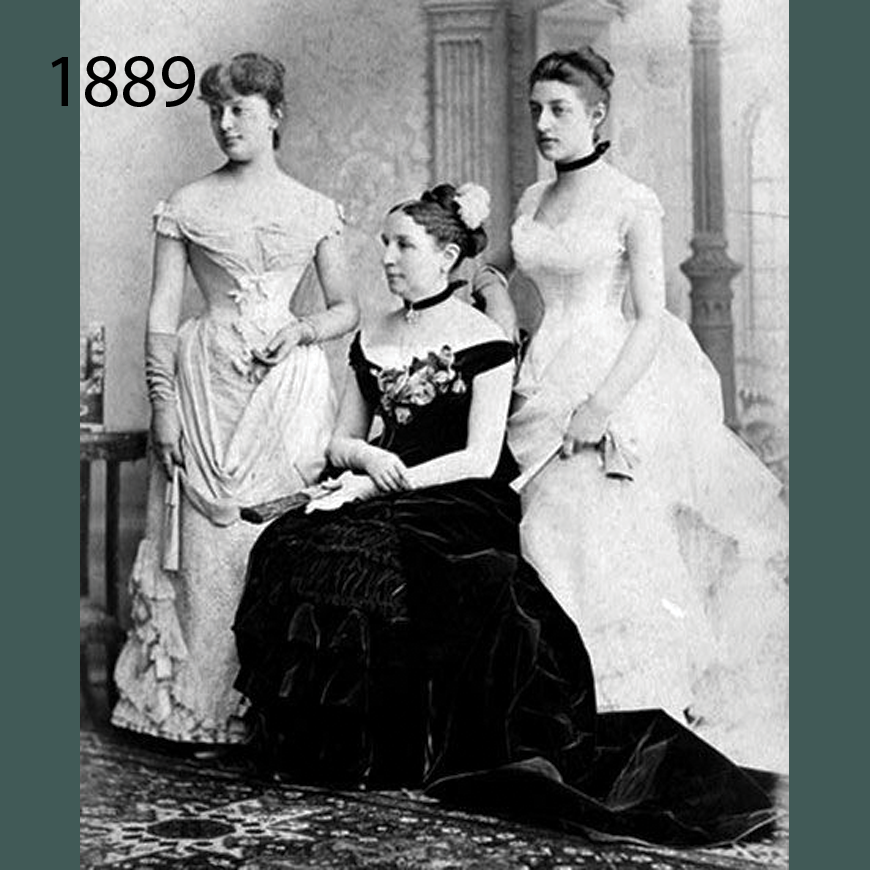
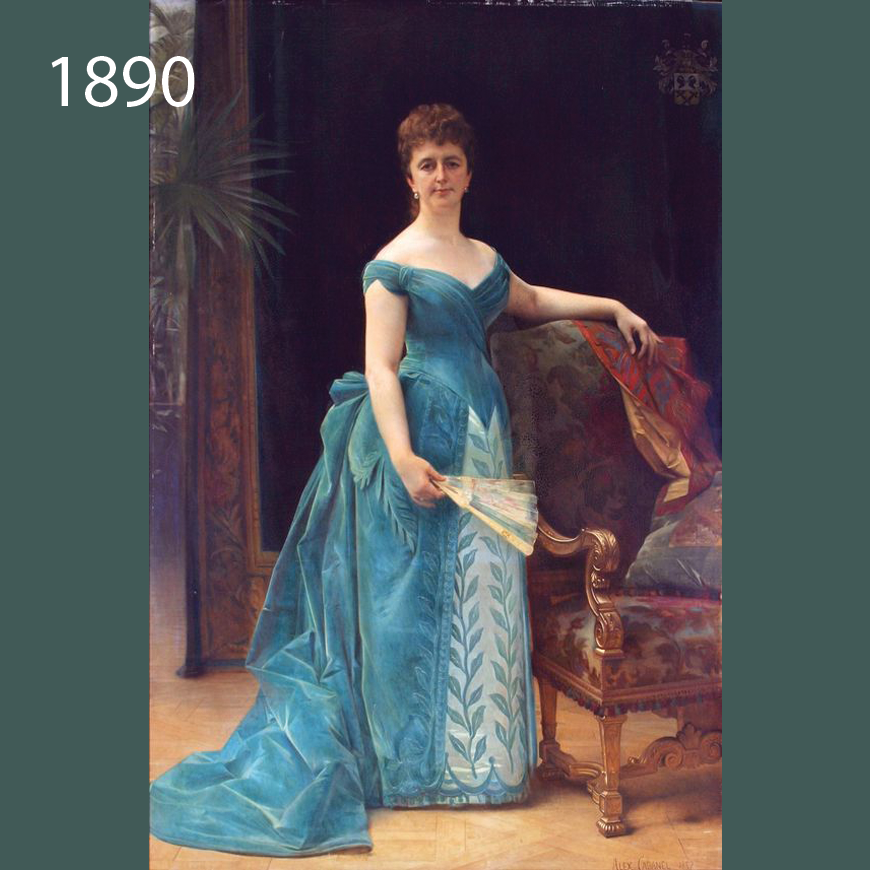


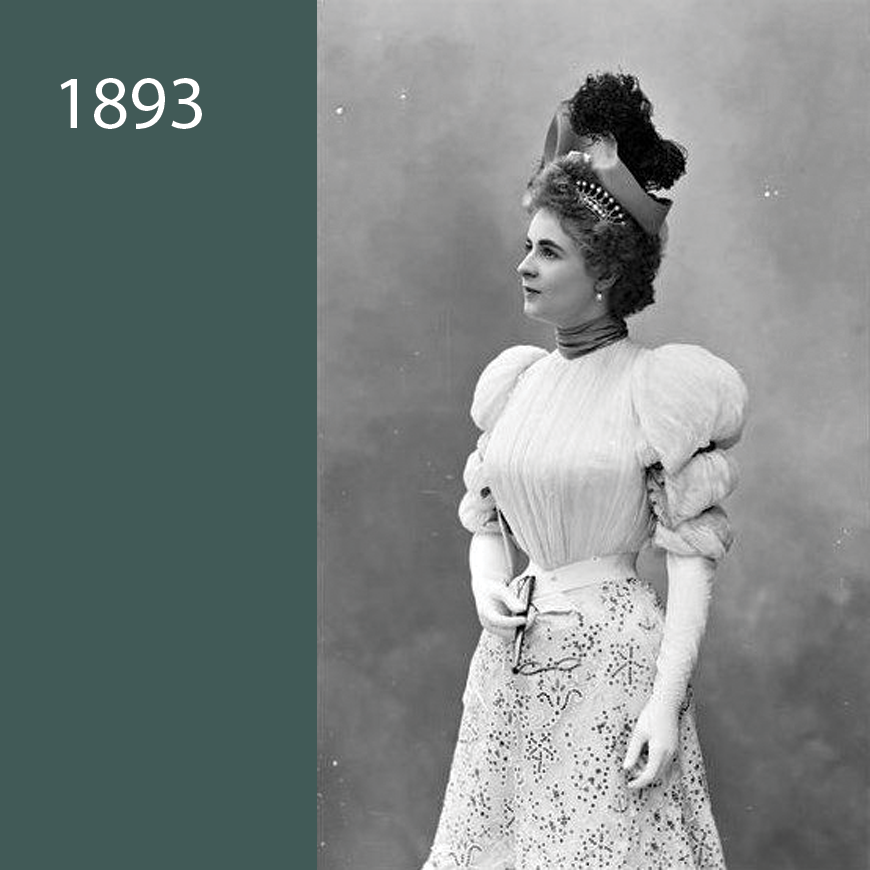

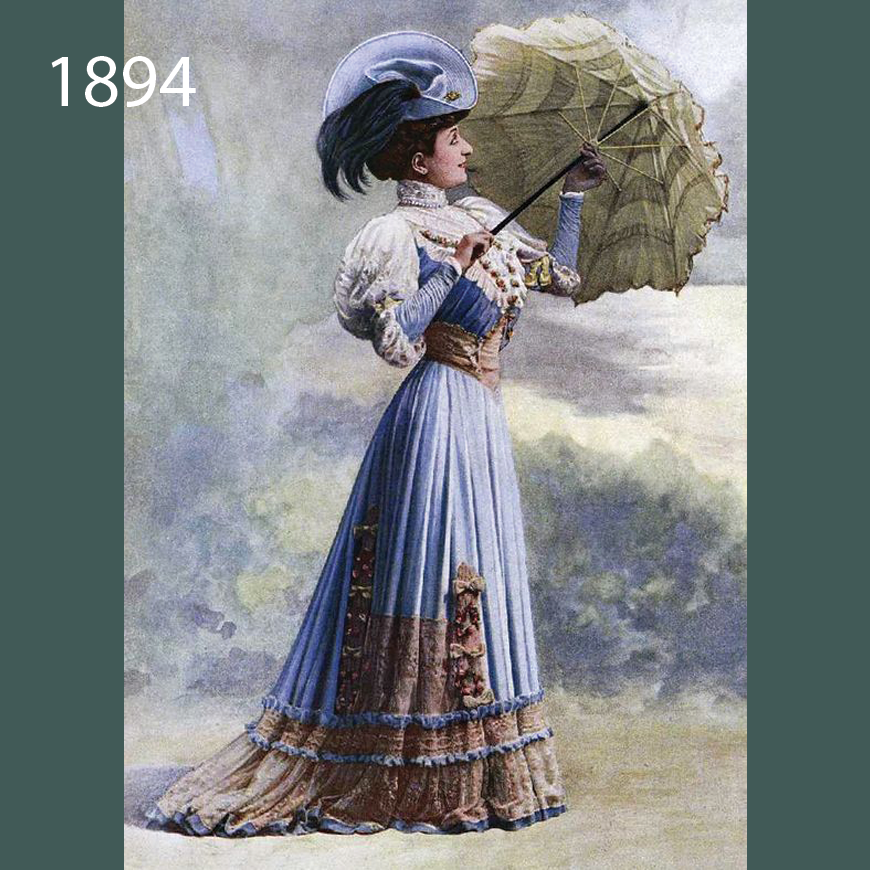
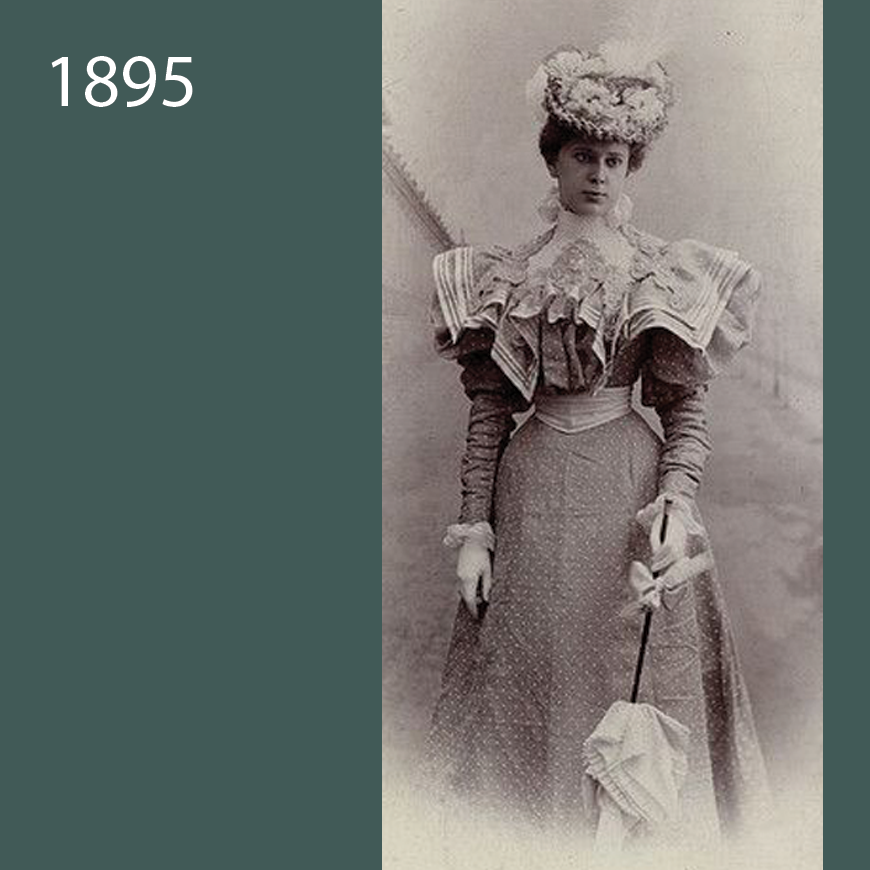
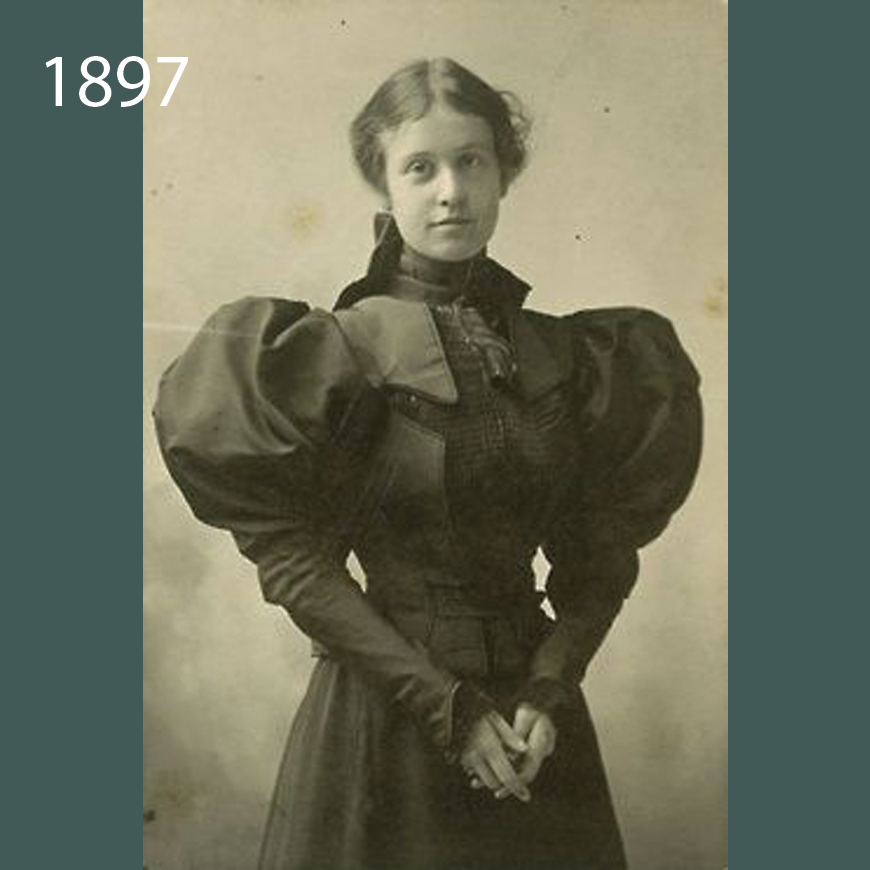
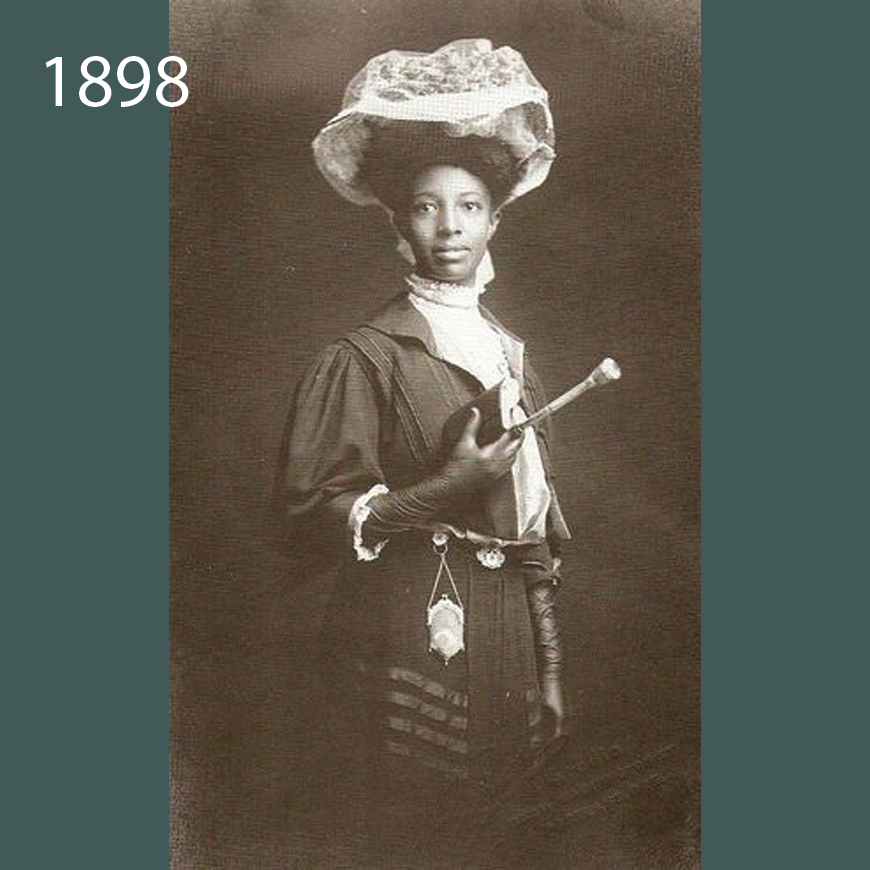
 —— WORLD SITUATION ——
—— WORLD SITUATION ——
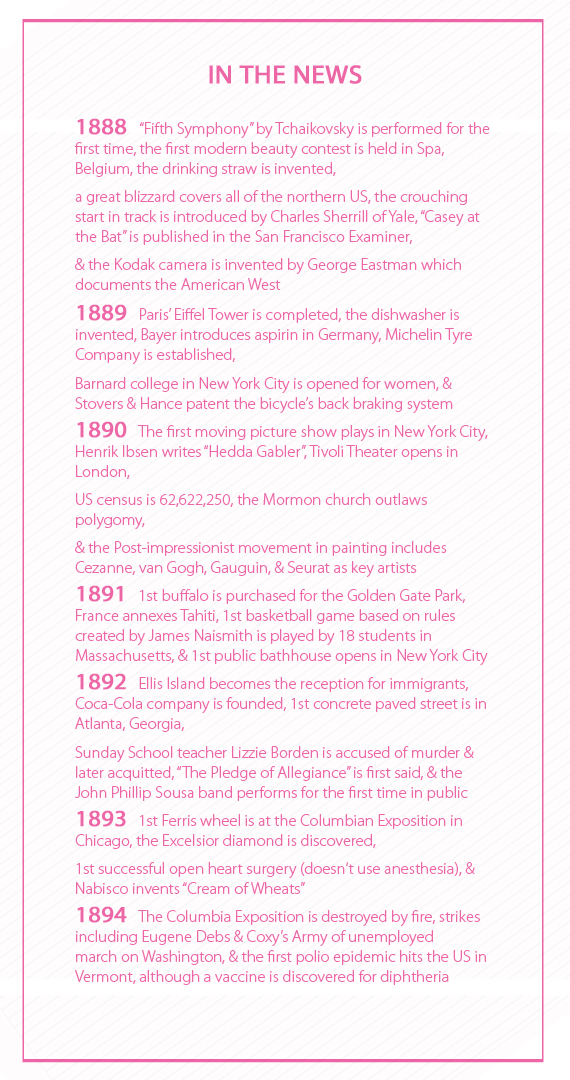
-
- By 1889, England & European countries were at war again, this time in Africa
- Conflict & change of power led to the start of the American-Spanish War
- The Philippines became independent of Spain, & China leased Hong Kong territories to the United Kingdom for 99 years
- College sports were invented for men & women including cheerleading for American football
- Sports were in great popularity
- Literature about sports such as “Casey at the Bat” was in great popularity too
- The Eiffel Tower was completed in Paris
- The Columbia Exposition in the US showed all the new innovations to the world
- A gold rush in the Yukon opened up exploration & trade
- Communication & trade continued to expand worldwide
- Literature & art expanded into new realms of thought such as “The Time Machine” & Impressionist painting
- The first modern Olympics were held in Athens
- Innovations continued including development of automobiles, fast ships,& machine guns
- Inventions kept coming, including the Ferris wheel, Kodak camera, & Bayer aspirin
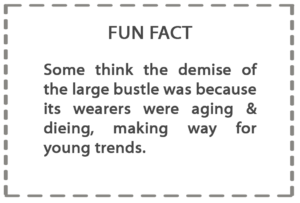
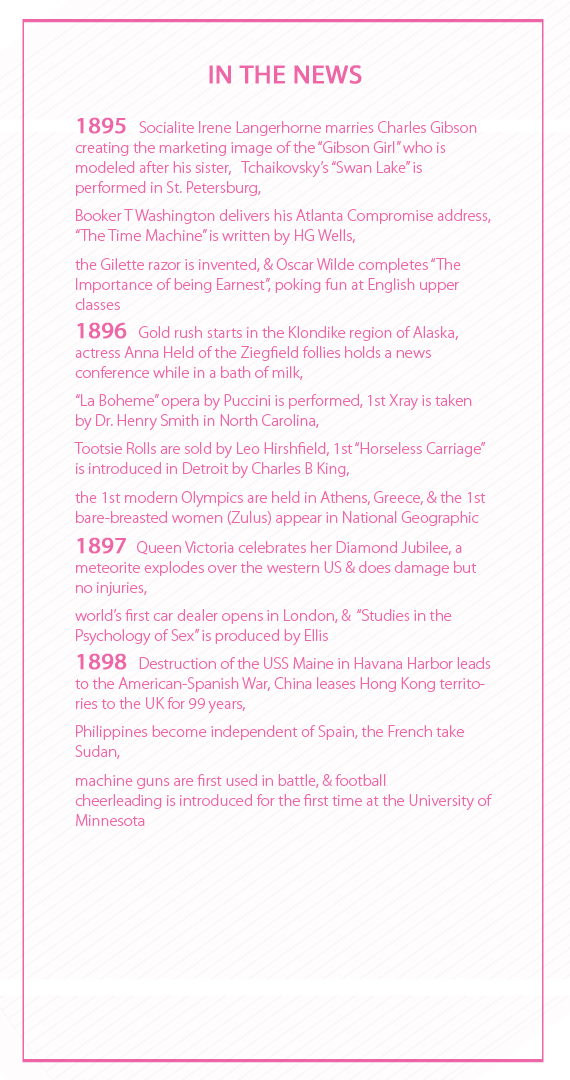
 —— FACTS OF THE TIME ——
—— FACTS OF THE TIME ——
-
-
- This time was yielding completely to the confident, strong, independent woman
- It was the transition between the Victorian era of restraint, & the loose fanciful life of the Edwardian
- The Victorian era had spanned 64 years, & changes in attitude were constantly shifting during that time
- Roles of women & women’s independence had somewhat paralleled the life of Queen Victoria herself who was crowned at age 18, & grew up during her reign
- The Edwardian era was named for Edward VII King of England who loved extravagant pleasures with balls, house parties, travel, athletics, & mobility
- Edwardian was defined by the laces, frills, & fluff of a FEELING
- In a fast-paced world of technological change, Edwardians tried to recapture a romantic & nostalgic past
- The era focused on a leisure class with leisurely pursuits
- Cars, races, & the drive towards women suffrage marked the time
- There was tea on the terrace alongside garden parties, regattas, & bountiful picnics
- Social & political structure was built on a rising middle class due to the industrial revolution
- The middle class “aped” the upper class
- Middle & upper classes had outfits specific to every occasion & activity
-
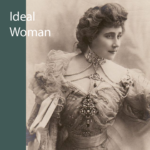 ROLES
ROLES
-
-
- The attitude of men in the period was highlighted by the author Tennyson who wrote of “women staying by the hearth with their needles whilst men wielded their swords”
- By the end of Queen Victoria’s reign there were great differences apparent between classes, & this could easily be seen by the garments they wore
- The Victorian head of household dressed his women specifically to show off wealth
- A wealthy woman’s day was governed by rules of etiquette requiring up to 6 wardrobe changes a day, & 3 seasons of change
- Fashion plates were keys to give visual clues about how to dress for status
- For the very poor of Britain things were quite different. For them, 5th hand clothes were typical, as the average poor mill worker could only afford the food left over from a rich household, & survived on inferior meats, tainted breads, porridge, cheese, herring, or kippers
- The most acceptable career for all women was still marriage
- For the upper classes & rising middle class, to prepare for courtship, the typical girl was groomed like a racehorse
- She was required to sing, play an instrument, speak French or Italian, & to be innocent, virtuous, biddable, dutiful, & ignorant of intellectual opinion
- Women were expected to remain within marriage or outside of it as weak & helpless as a delicate flower incapable of making decisions beyond selecting the menu & ensuring her children were taught moral values
- A gentlewoman ensured the home was a place of comfort for her husband & family, away from the stresses of an industrial world
- An Edwardian woman’s prime use was to bear a large family & maintain a smooth family atmosphere so a man need not bother with domestic matters. He assumed the house would run smoothly so he could spend his focus on making money
- A wealthy wife was supposed to spend her time reading, sewing, receiving guests, going visiting, letter writing, seeing to servants, & dress the part of her husband’s social representative
- Even in high society, men kept mistresses, yet their wives were expected to be faithful no matter what
- If a woman took a lover, it was not made public, or she would be cut out of society
- Men could have a mistress & be warmly welcomed everywhere
- It was a hypocritical period when relationships were artificial until 1887 when the Married Woman’s Property Act gave women the right to own property
- Before the Act, anything a woman owned became her husband’s at their marriage, including herself
- If a wife separated from her husband, she had no rights of access to see her children, & no chance of acceptance in society ever again
- The Act changed all of that
- Fashion history usually depicts the style of those with wealth, & who met these cultural standards, showing typical excessive elements such as tiny V waists, layering of trims, & gigantic sleeves
- As the 1880’s progressed, dress became more & more lavish until clothing was nearly buried by lace & beading at the turn of the century
-
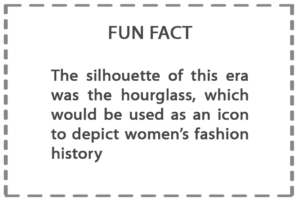
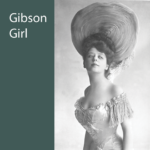 YET ANOTHER IDEAL WOMAN EMERGES
YET ANOTHER IDEAL WOMAN EMERGES
-
-
- The Gibson Girl the new ideal woman. While models were found to depict her, she never really existed
- This imaginary woman had large bosoms & hips, snub nose, small mouth, & upswept full hair
- The Gibson Girl was almost a merge of the extremes of the bustle era with all its draping, folds, & fuss, the Edwardian concept of the “Grand Dame” with her lace & tea, & the smooth lines of the natural forms & frizzy hair of “Aesthetic dress”
- The Gibson Girl image of the 1890’s combined elements of older images of caucasian female beauty: the “fragile lady” with slender lines & a sense of respectability & the “voluptuous woman” with large bust & hips who was never vulgar or lewd
- She was refined in beauty, spirit, & was calm, independent, confident, & sought personal fulfillment
- Portrayed at ease & always stylish
- She was often depicted attending college & vying for a good mate
- She would NEVER participate in the suffrage movement
- A member of upper class society
- More athletic-shaped; she was often depicted cycling in Central Park
- She exercised & was emancipated to the extent she could enter the workplace
- She had an exaggerated “S” curve torso achieved by wearing a swan bill corset
- The Gibson Girl Preoccupation with youthful features & ephemeral beauty
- She had a thin neck & her hair was piled high on her head in bouffant, pompadour, or chignon “waterfall of curls”
- The new image would be rehashed in each generation, eventually evolving into the “girl next door”, a national standard of wholesome beauty by standards of the ideal femininity of the time
- Of course, the Gibson Girl was invented by a man
- He created her based on his sister, & marketed the idea very successfully throughout the world
-
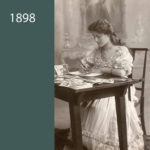 SCIENCE IN FASHION
SCIENCE IN FASHION
-
-
- Scientific study of the human body called “anthropumetrics” had changed the design of drafted patterns so they could be standardized
- Women could now successfully sew garments in the home
- Catalog & department stores could make multiples in sizes for true “off the rack” or “ready made”
- Growing urbanization & rapid growth of technology included improvements in city living conditions
- Designers, builders, & manufacturers used “proportionate systems of measure” which applied to the fashion industry too
- In 1884 Dr. Jaeger, a German professor of Zoology in Germany, developed scientific theories about the hygiene of dress, & recommended the wearing of only wool next to the body
- Dr. Jaeger promoted the use of natural fibers in everything in the household to “prevent retention of noxious exhalations of the body”
- Science at the time was equated with being modern, & therefore regardless of Dr. Jaegers lack of scientific data, his research became the foundation for “dress reform”
- This led to many wool garments being produced in a range of colors
-
 ART IN FASHION
ART IN FASHION
-
-
- Oscar Wilde, philosophical writer of 1894 said “one should either be a work of art, or wear one”
- He also wrote “fashion is a form of ugliness so intolerable that we have to alter it every six months”, “Fashion is what one wears oneself & what is unfashionable is what other people wear”
- Wilde & his wife promoted a return to natural forms of the “bohemian” style which had been introduced in the previous decade through “Aesthetic”, “Artistic”, & “Pre-Raphaelite” movements
- It was now called “Rational Dress” or “Dress Reform”
- The “Aesthetic” & “Art” movements of the last era were still in full force too
- The 3 concepts would lead to the “Art Nouveau” style of the next era
- Officially “La Belle Epoque” era was 1890-1914, so the influence of that high fashion style begins at this time (discussed as a separate era here)
- Magazines & catalogs dictated fashion
-
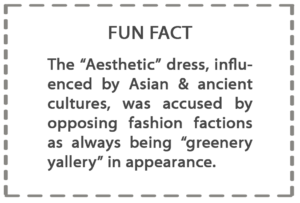
 —— FASHIONS & TRENDS ——
—— FASHIONS & TRENDS ——
-
-
- During these years the picturesque “Directoire” style evoking the late 1700’s & early 1800’s was revived
- Directoire elements included tailored redingotes cut back to expose a contrasting skirt, embroidered & brocaded vest effects, dresses with empire waists, & puffy fichus
- There was also an increasing emphasis on fancy sleeves
- This trend was inspired by the 1830’s which were in turn inspired by the 16th century Middle Ages
-
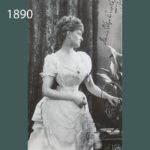 SILHOUETTE
SILHOUETTE
-
-
- Fashion of the 1890’s is overall characterized by long elegant lines, tall collars, & the rise of sportswear
- “Rational Dress” for women’s health was widely discussed in 1891, which led to the development of the sports dress
- Both the extremely tight & fitted corsets & fussy bustle styles existed alongside the rise in “naturalness”
- The silhouette progressively deflated from that with had considerable back fullness & puffy draperies, to the narrow one of the early 1890’s
- Foreign fashion brought influences, especially the red tunic, the “curiass” bodice, & the “prussian” very high neck collar
- The 1890’s were an era of great dress reforms with unfussy, tailored clothes, adapted from the earlier theme of men’s tailoring
- The sharper tailoring of the era, combined with gigantic sleeves & huge hats, gave women a posture that made them look more confident to reflect the ideal of emancipation
- They also put women off balance
-
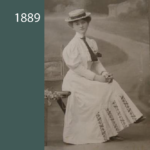 SIMPLICITY & FUNCTION
SIMPLICITY & FUNCTION
-
-
- Simplicity of form was apparent in clothing worn for outdoor activities & travel
- Women were earning their living as governesses, shop assistants, & typists
- The working woman embraced the tailored coat & skirt later called a “suit”
- The shirtwaist, a costume with a bodice or “waist” tailored like a man’s shirt with a high collar, was adapted for women’s informal daywear, & became the uniform of working women
- The tailor-made woman’s suit of the 1890’s had a 3/4 length jacket, wide revers, enormous sleeves, a plain skirt that reached to instep or ground level, & might also sport a waistcoat
- Later in the era, & despite intensive marketing of French fashion houses through magazines & American periodicals to keep it out, the tailor-made suit elevated the combination blouse (“shirt waist”) with skirt into high fashion
- The “suit” had come to be accepted in all venues from walking to work to high tea
- The 1890’s suit had a somewhat masculine style which reflected the working woman’s desire to look smart, but to also increase their ability to be active, or to create the appearance of being active
- Walking Suits featured ankle-length skirts with matching jackets
- The blouse, worn with the suit or without, became popular in 1894
- It was caught in at the waist with a fixed belt, & then a short peplum would extend under the belt
- Ready-made blouses could be bought in great variety from very masculine to dressy for formal wear
- Most of them, with the new scientifically based sizing systems, actually fit
-
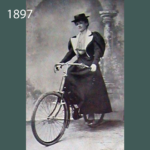 SPORTS
SPORTS
-
-
- Sports dresses included ample skirts with belted blouses
- In the United States, bloomers were used more for exercise than fashion
- American women were the first to embrace bloomers. Necessity of living, especially in the frontier west, had women already wearing men’s clothing, so it was not a large leap from skirt to pant
- The rise of American women’s college sports in the 1890’s created a need for unencumbered movement
- By 1900, all American women’s basketball teams were outfitted in bloomers
- On college campuses, bloomers were paired with blouses to make the first gym uniforms worn in public by women
- Bicycling was THE most popular sport. Groups were formed, including bicycles built for two (tandems)
- Sundays were often spent with whole families cycling together
- Skirts had to be shorter, or be able to lift up to get on a bike
- “Cycling Costumes” had shorter skirts with bloomers or Turkish split trousers
- That women could bicycle in huge skirts was as amazing as that they could climb mountains in bustles, which they did at this time
- By 1890, while American women had already embraced them, women of England, France, Germany, & the Netherlands gave in to the need for some sort of split garment
- They picked up the previously discarded Bloomers
- Bloomers were a type of “knickerbocker” (“knicker”) modest pantaloon named for their inventor Amelia Bloomer in 1850
- Amelia’s original design had been what she called “baggy pantaloons” which were worn beneath a tunic that reached to or above the knee
- Ms Bloomer was part of the Dress Reform movement, & she was highly ridiculed & caricaturized
- With “Dress Reform” gaining popularity, & the need for cycling apparel, people finally stopped laughing at her
- The “Rainy Daisy” was a type of walking or sports skirt introduced in the 1890’s
- The “Rainy Daisy” was named after Daisy Miller, leading character of a book by Henry James published in 1879. The book tells the story of a young American woman traveling in Europe, who is courted by Frederick Forsyth Winterbourne, an American living abroad. It deals with prejudices & the differences between social cultures of America & other countries
- The “Rainy Daisy” was known for practicality in wet weather, as the short hemline kept the skirt out of puddles
- These were worn for all sporting pursuits & bicycling
- The bathing costume was perhaps the greatest innovation of the era, however
- Ensembles were made from grey serge, a fairly heavy wool, in one piece with top & drawers (knickers) with a belt so that it would not reveal the body
- Bathing costumes were so ponderous women would sink
- Eventually a knit suit was developed so a woman could actually swim
-
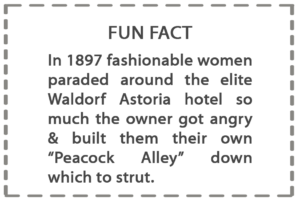
 —— FASHION SPECIFICS ——
—— FASHION SPECIFICS ——
-
-
- Some think the demise of the bustle was because it’s wearers & fans were aging & dieing
- Afternoon dresses typical of the period had high necks, wasp waists, puffed sleeves, & bell shaped skirts
- Evening gowns had squared decolletage, wasp-waisted corsets, & skirts with long trains
- Evening & ball gowns were worn with or without trains
- Walking suits had short skirts & matching jackets
- The bustle was gone entirely by 1890
- Only a small pad to lift the rear skirt fabric was left by 1893
- Gathers at the back of the skirt remained until 1900
-
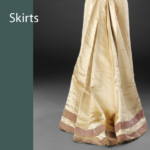 SKIRTS & SUPPORTS
SKIRTS & SUPPORTS
-
-
- In 1885 the skirt had become very stiff, fitting over the hip & shaped into thick umbrella-like pleats
- The shape of the skirt then gradually became a slimmed down version of that through the end of the 1880’s
- By 1890, skirts fell naturally over the hips
- Skirts changed through the period from the wide, horse hind shape to a gentle & graceful bell or “inverted lily flower” which fit closely over the hip, & then flared just above the knee
- The skirt continued to widen & flare as the fullness of the bustle began to fall into pleats instead
- All the fullness that had been draping the bustle disappeared in favor of a smooth line
- Skirts widened in a straight line after the hips to the start of the hem flare
- Skirts were gored & not gathered nor pleated to give a fairly close-fitting effect over the hips
- Some cartridge pleating from the waistband was retained at the back along with some padding to make the hips appear rounded, although it was no longer fashionable to have large hips
- By 1894, skirts were relatively free of decoration
- After 1894, decorative panels extended from the bodice & continued down the skirt with braid or fringe on the edge of each panel
- Different from the simple trims & pleats of the English & American, French gowns were always richly embroidered or trimmed
- By 1899 the flare in the skirt was more pronounced & dramatic
- The bottom of some skirts was cut as a shaped flounce; a design that would carry into the 1900’s
- As skirts became plainer, the tight high-necked, high-busted, & long-waisted bodices became more ornate
- Many skirts had trains for both day & evening wear
-
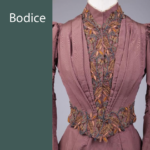 BODICES & JACKETS
BODICES & JACKETS
-
-
- Dresses of the early 1890’s had tight bodices that were gathered at the waist
- After that, bodices began to have even more fullness at the front, which would develop into the pigeon breast or monobosum of the early 20th century
- By 1897, most bodices were gathered evenly all round at the bottom & had a belt which mostly went straight around
- The belt sometimes dipped at the center front
- Bodices had lace jabots & frills including cross-overs or epaulettes of military influence
- Increasing width at the shoulder was balanced by adding width at the hemline
- The bodice shape hardly changed until after 1907, so there was a basic bodice design from which all others just varied
- Bodice variations included square or round necklines
- Necklines rose even higher through the era, supported by very high boned collars
- Special devices were invented to hold collars & peplums to shape. Most of these were wired
- Peplums of various lengths were popular on the bottoms of bodices & jackets in 1894-95
- Peplums were short gathered “fan” like folds of fabric which covered the top of the skirt
- They were faced with silk taffeta so the jacket would slide smoothly over the skirt without riding up
- The Zouave jacket, still popular from the 1860’s, became more tailored at this time
- The bottom of the Zouave was square or rounded
- It fastened across with frogs or tabs, & was worn open or fastened
-
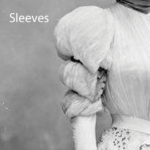 SLEEVES
SLEEVES
-
-
- By 1889 sleeves were huge & needed support
- By 1894 the sleeve puff had become enormous, & the fullness dropped level with the shoulders rather than going upwards as in the previous era
- 1895 sleeves were huge with stuffed Melons, Balloons, & Legs o’Mutton styles
- Sleeves got bigger & bigger until they disappeared in 1896 with the more proportioned styles of “La Belle Epoque”, “Art Nouveau”, & late Edwardian
- The gigot sleeve had also declined in size & popularity by 1897
- The new sleeve of 1898 was more slender, & the head was cut with a built-in puff
- Sleeves got slimmer in 1899
- 1899 sleeves were tight at the wrist & had small puffs or ruffles capping the shoulder. The head still had some fullness
- Late 1890’s sleeves had ruches from wrist to armhole, which looked like wearing bandages
-
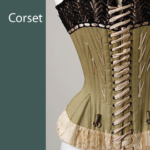 CORSETS
CORSETS
-
-
- The early Edwardian corset is the same as the prior era, except that the bones did not follow the seams of the pattern pieces because the aim of the Victorian period was to smooth out the line of the body, while the Edwardian was to emphasize waist & hips
- Although not intended to be visible like stays of the 18th century, corsets of the 1880’s to 1890’s were elegant & beautifully made
- Black sateen was sewn with yellow, blue, pin, or green decorative machine stitching, & then embroidered by machine or hand
- A wedding corset might be of white satin embroidered with orange blossoms
- Being cut with separate hip pieces, the 1890’s corset results in a “nipped in” waist appearance
- The rib cage was resultingly compressed so the hip bones protruded
- It was arranged in such a way that when the stomach was pushed in, the whole torso tipped forward
- By the end of the era, heading into the Edwardian period, corsets & the body became elongated to an “S” curve that carried forward into the 20th century
- A woman of the time described how it felt to wear the current corset fashion: “although perfectly straight & well made, I was enclosed in stiff stays, with a steel busk in front; while above my frock, bands drew my shoulders back till the shoulder-blades met. Then a steel rod with a semi-circle, which went under my chin, was clasped to the steel busk in my stays. In this constrained state I & most of the younger girls had to prepare our lessons”
-
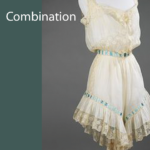 UNDERGARMENTS
UNDERGARMENTS
COMBINATIONS & DRAWERS
-
-
- Throughout this period women’s underwear became more elaborately trimmed & progressively prettier & more alluring
- The decorative period culminated in the 1890s with ‘frou-frou’ petticoats
- By 1890 the chemise & drawers were almost completely replaced by combinations because they reduced bulk around the waist
- A combination was a camisole with attached knee or calf length drawers
- Combinations were worn under the corset, bustle, & petticoat
- By 1899 some drawers were wide-legged & flared
- The drawers, called “knickers” in reference to the previous era’s bloomers were worn
- Whether wide or narrow legged drawers used flat lace, inserts, or ribbon on the hems so as not to disrupt the line of the dress instead of ruffles & edging trims of the past era
- Knickers were split at the crotch
- They had a straight or slightly “v’d” or dropped waist band to keep the front waist area flat
-
CAMISOLES, CORSET COVERS, & VESTS
-
-
- In the 1890’s a short-sleeved or sleeveless under-bodice & over corset light muslin or silk blouse called a camisole was worn
- When a chemise or camisole was worn, knickers were worn instead of the combination
- The corset cover, camisole, or petticoat bodice was worn over the corset to protect the tight fitting dress from being damaged by rubbing
- By the 1890’s, corset covers or camisoles were sleeveless & very glamorous with frills, tucks, lace trimmings, & ribbons
- Undervests of colored washable silk with shaped gussets for breasts were worn under the corset to absorb sweat & prevent chafing
-
CHEMISES
-
-
- By the end of the century, the chemise had become a very simply cut, sleeveless garment with narrow shoulders
- The chemise had a round, square, V or heart-shaped neckline
- It was very highly decorated with lace & embroidery & was made of fine cotton, linen, or silk
- A separate type of chemise was worn with evening sleeveless, decolletee dresses
- The evening chemise was cut straight across the top, with separate narrow shoulder straps, a style that would remain popular into the 20th century
-
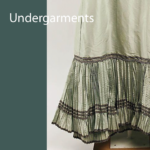 PETTICOATS
PETTICOATS
-
-
- The petticoat was made to stay as flat as possible along the front to maintain the smooth line of the bodice
- The triangular silhouette of the gored petticoat was further emphasized by a lace-trimmed frill at the bottom
- As skirts softened in outline in the late 1890’s to give a curved flare below the knee, petticoats followed the shape
- Petticoats often had circular flounces at the bottom
- This straight, curve, flare, & flounce line would characterize skirts & petticoats until about 1914
- Stiff silk or alpaca petticoats were worn as well as cotton
- Flannel was still used for petticoats, although it was sometimes too bulky for the slim line of the style
- Silk petticoats produced the characteristic rustling sound that marked the ’90’s era
- The silk rustling sound was called “frou-frou”
-
AND MORE
-
-
- The Dress Reform movement, wanting to reduce the number & weight of garments a woman wore, took the concept of the combination to create a “combination divided skirt”
- This was the chemise & drawers combined as seen in the regular combination, but it had also had long wide legs that were intended to replace the petticoat as well as provide service as the underdrawers
-
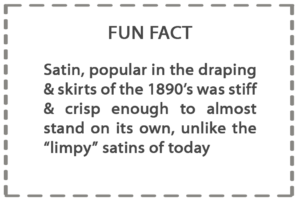
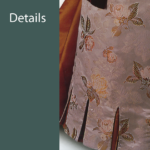 FABRICS & MATERIALS
FABRICS & MATERIALS
-
-
- Lace, gauze, a thick silk (mousseline de soie), ribbon, silk chiffon, tulle, crepe de chine, & specially made lacy details were used
- Designs from French couture houses had extravagantly expensive elaborate gowns in velvet or satin
- Gowns of the late 1880’s were almost always made of 2 colors of material
- As in the past era, vivid colors produced by the new & innovative dye processes such as deep red, peacock blue, bright apple green, royal blue, purple, mandarin, sea green were used along or in combination with tartan fabrics
- Some color combinations were very strange
- At night ladie’s evening dresses were of softer hues & were extravagantly trimmed in contrasting fabrics with much ornamentation at the neckline
- Women wore pastels for day or evening
-
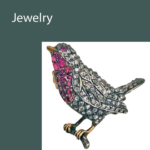 JEWELRY & ACCESSORIES
JEWELRY & ACCESSORIES
-
-
- Matching jewelry included work of Renaissance, along with Greek, Egyptian, & other ancient societies
- There were corals & cameos of many many designs used in brooches, earrings, necklaces, & pins
- Cameos were small motifs of people & animals, often carved in bone or a semi-precious material such as pearl or opal
- Jewelry was often worn over gloves
- Sentimental jewelry was made from the hair of a loved one
- Women put the hair from their hairbrush into a special box each day, & when they had enough, they would weave bracelets or necklaces from it
- Late Victorian jewelry was very complex & ornate with diamonds & emeralds
- Paste was worn often, & there was a large industry for creating replication jewelry
- Parasols were used for every event & outing except when participating in sports
- The difference between a parasol & an umbrella was that the umbrella was large enough to protect one from rain or sun
- Parasols were for appearances
-
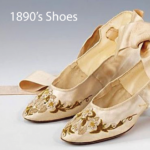 FOOTWEAR
FOOTWEAR
-
-
- High heels were a necessity for any woman wanting to keep her dress clean
- The modern high-heeled boot appeared at this time
- It had evolved from the “clog” decades earlier in the time of Henry VI, & the loose heeled boot of a decade before
- The higher back of the “heeled clog” threw the weight forward, emphasizing the forward balance of the “S” corset line
- High tab front shoes with a large buckle were in style in the 1870’s, went out, & came back in style in the 1890’s
- Except for the shape of the heel, it was almost a nostalgic replication of the shoes of exactly 100 years prior
- Heeled shoes were named such as “Cromwell”, “Colonial”, & “Moliere”
- Suede, leather, lace, & metal were used to fashion the shoe & to decorate it
- Suede was new to the market in 1890, & was available in a few pale shades
- Boots, previously worn strictly for riding, were commonly worn for sports, work, or rural pursuits as well as travel
-
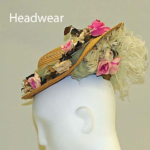 HAIR & HEADGEAR
HAIR & HEADGEAR
-
-
- Hair was fastened around pads with feathers & silk “frou frou” on enormous hats
- In 1890 hair wasmuch the same as in the 1880′
- This included styles with curled or frizzled bangs over the forehead, as well as hair swept to the top of the head
- After 1892, hairstyles were increasingly influenced by the Gibson Girl
- Hair became looser & waiver after 1895, & bangs gradually faded from high fashion
- By the end of the 1890’s the hair was often worn in a large piled mass with a bun at the top of the head. This style would predominate until after 1910
- Hats were described as very large & covered with “the bodies of dead birds”
-

 —— ACTUAL GARMENTS FROM ERA ——
—— ACTUAL GARMENTS FROM ERA ——
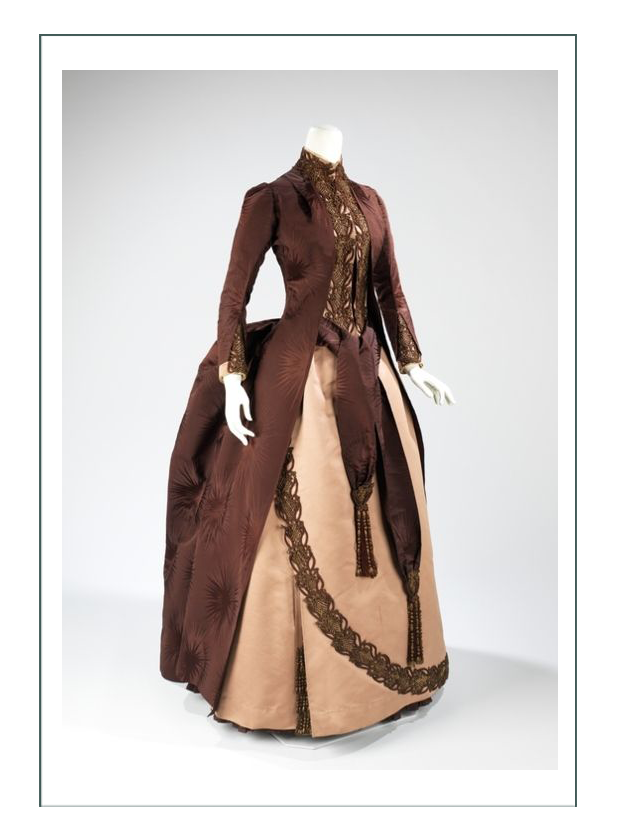
—— (above) “Era Begins with Biggest (2nd era) Bustle 1888” ——
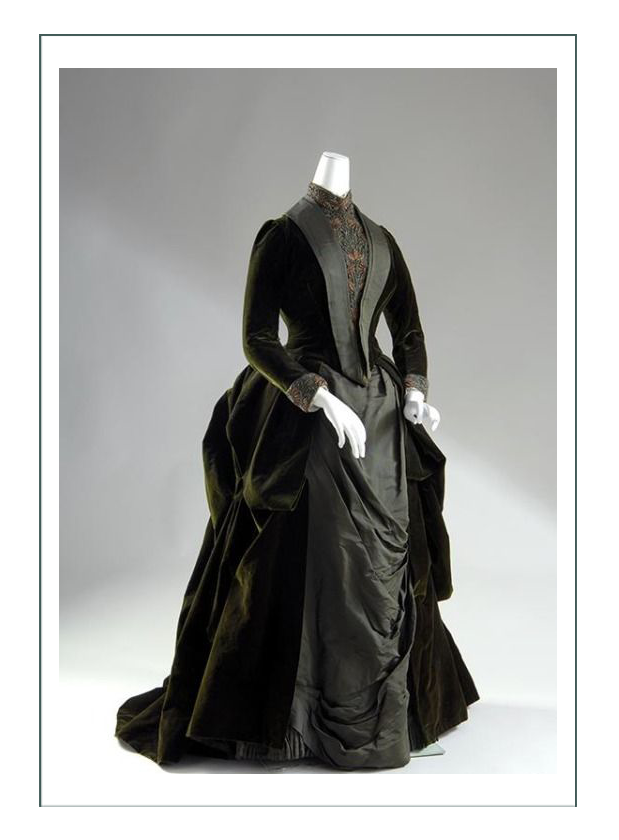
—— (above) “Winter Dress 1888” ——
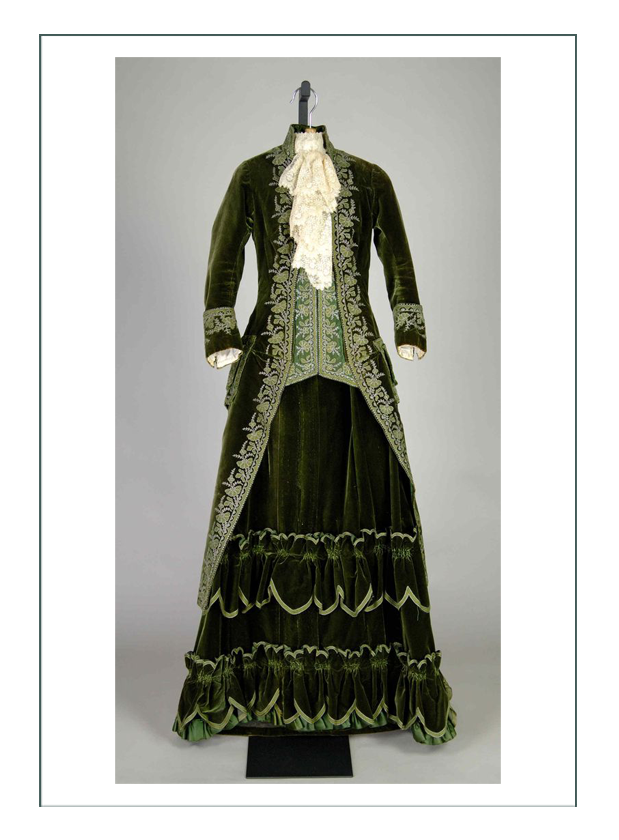
—— (above) “Walking Dress 1888” ——
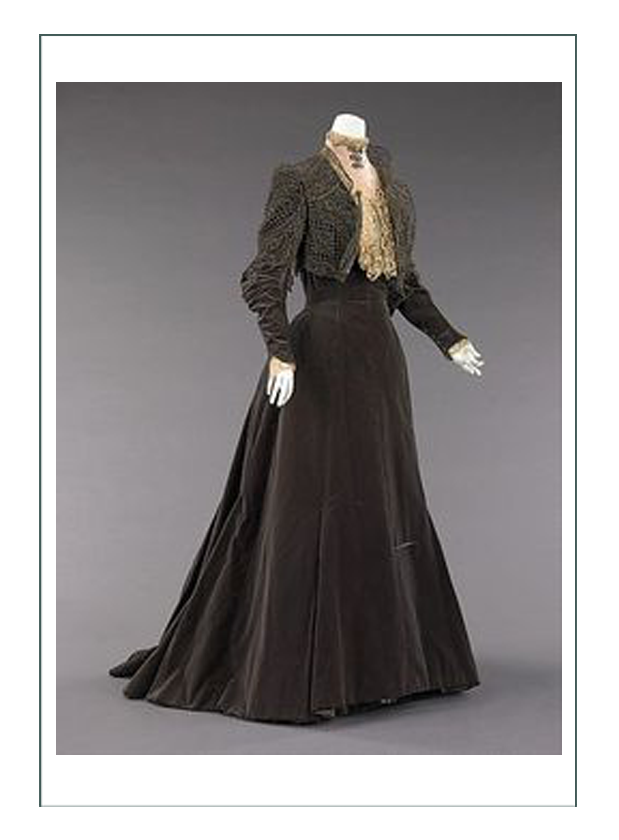
—— (above) “Worth Tailored Gown 1889” ——

—— (above) “Riding Habit 1890” ——
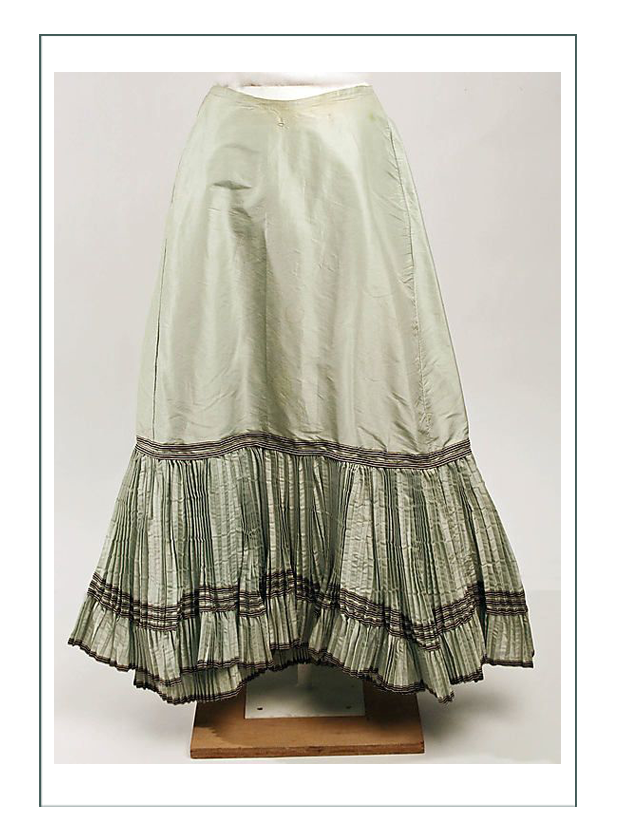
—— (above) “Petticoat 1891” ——
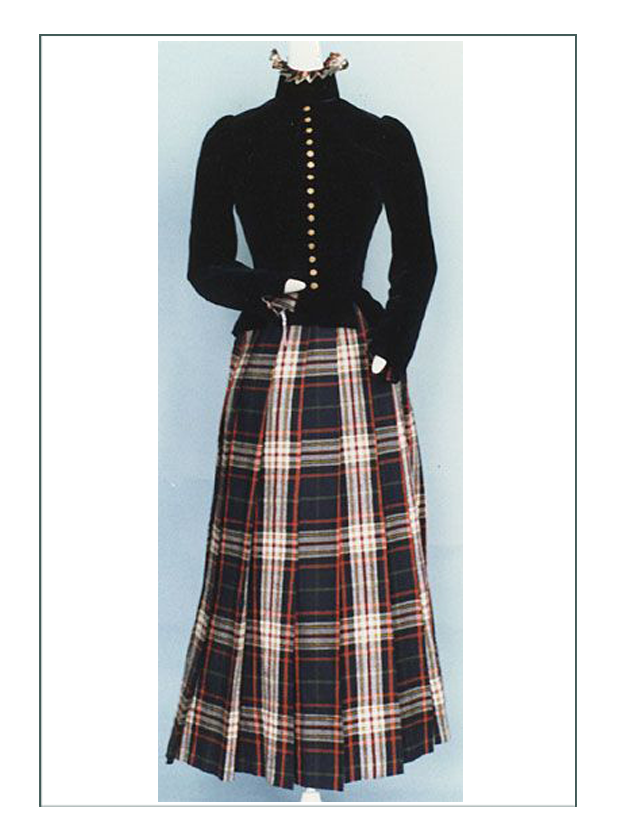
—— (above) “Outdoor Sporting Ensemble 1891” ——
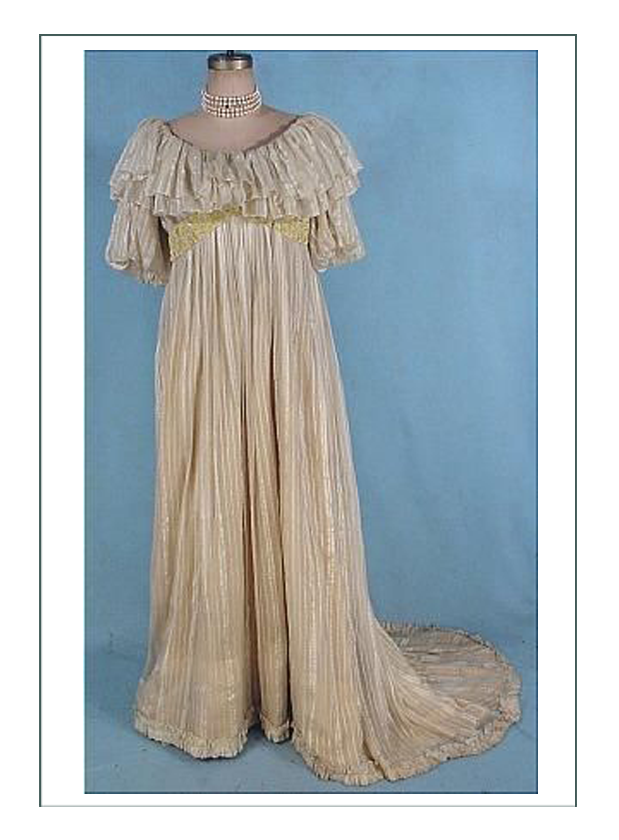
—— (above) “Undress (Negligee) 1892” ——

—— (above) “Finally, No Bustle 1892” ——

—— (above) “Day Dress Typical 1893” ——
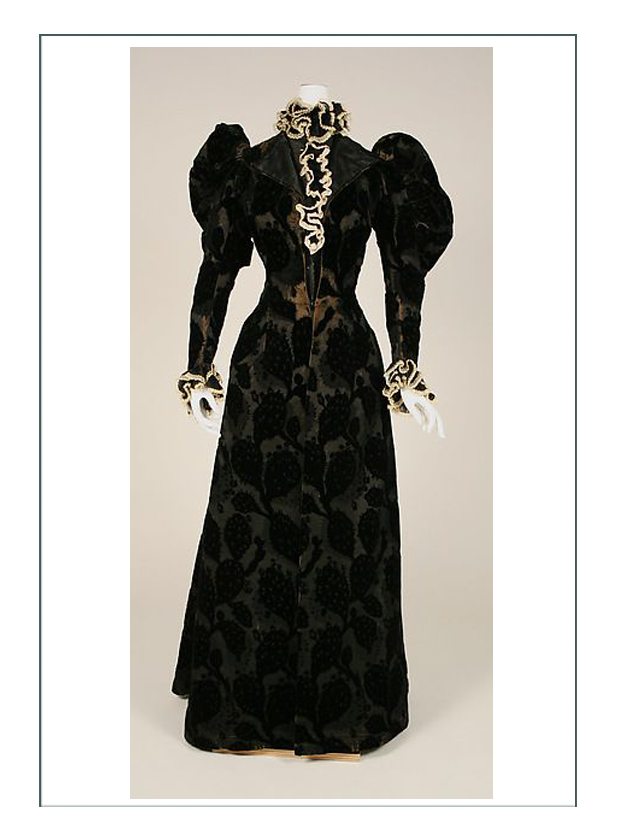
—— (above) “Redingote by Worth 1894” ——
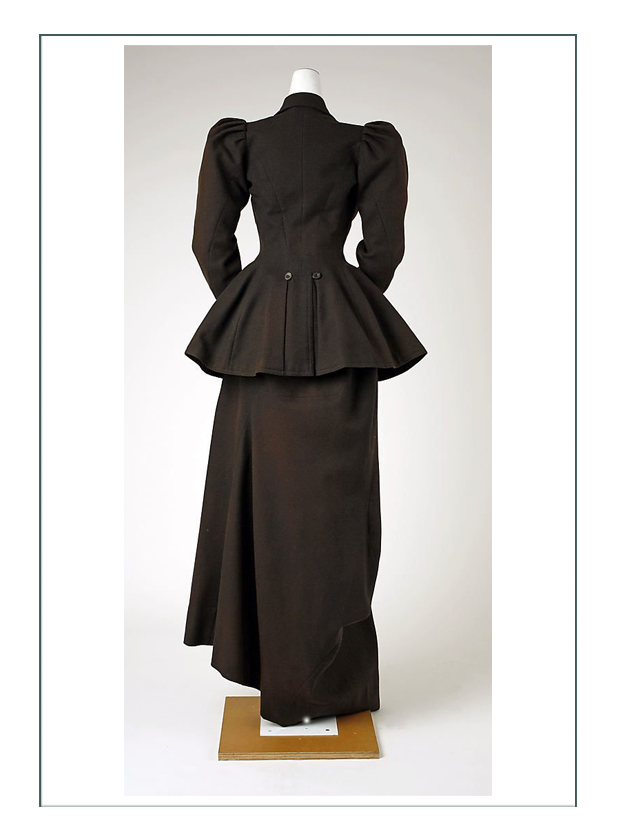
—— (above) “Riding Habit 1894” ——
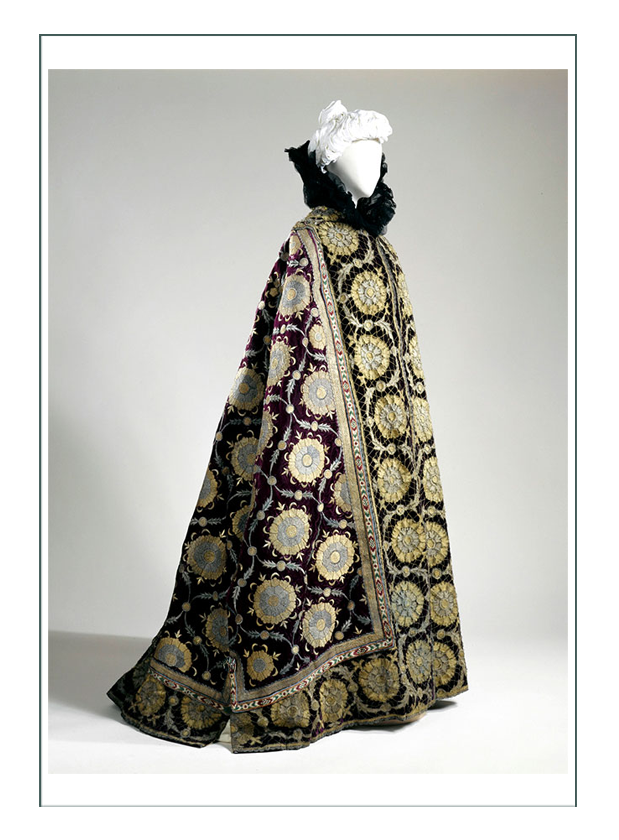
—— (above) “Opera Cape 1895” ——
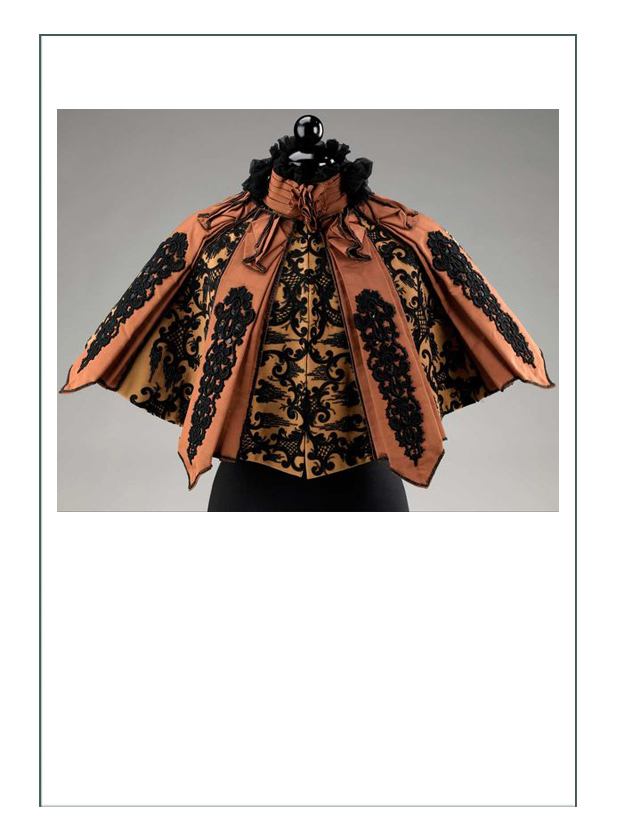
—— (above) “Wool Capelet 1895” ——
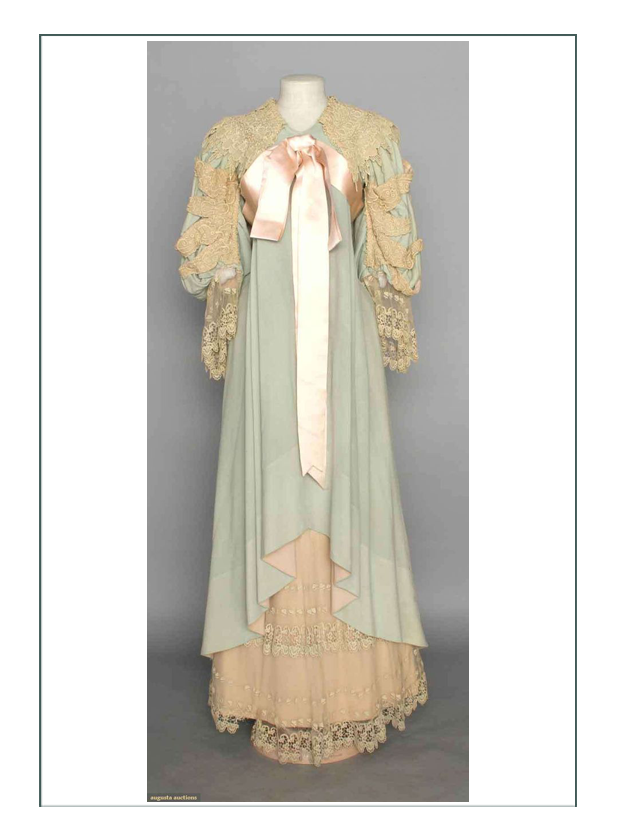
—— (above) “Morning Gown 1895” ——
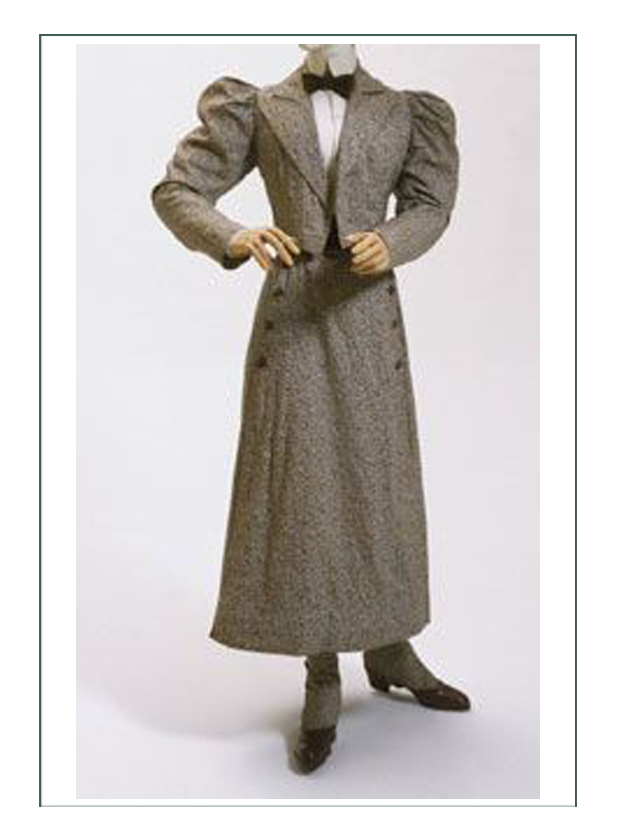
—— (above) “Bicycle Costume 1896” ——
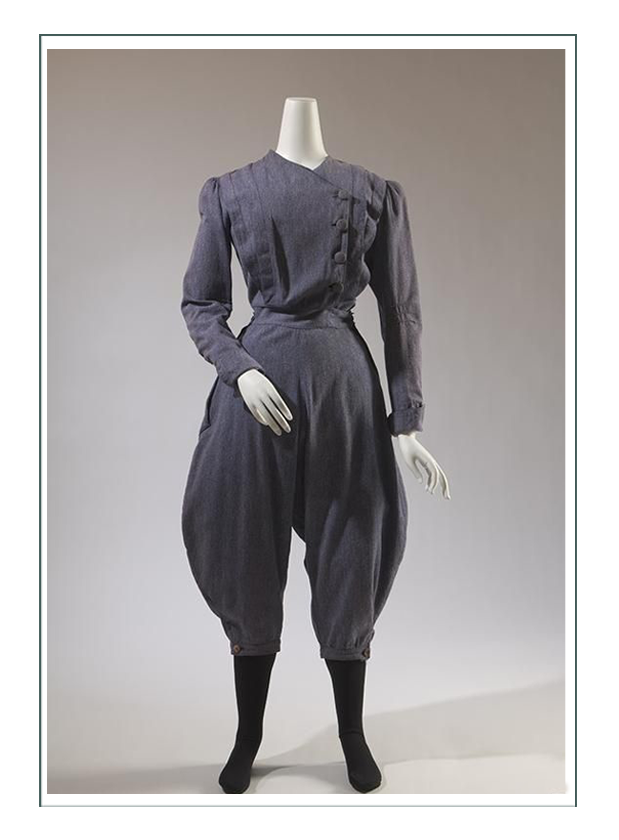
—— (above) “Gym Suit 1896” ——
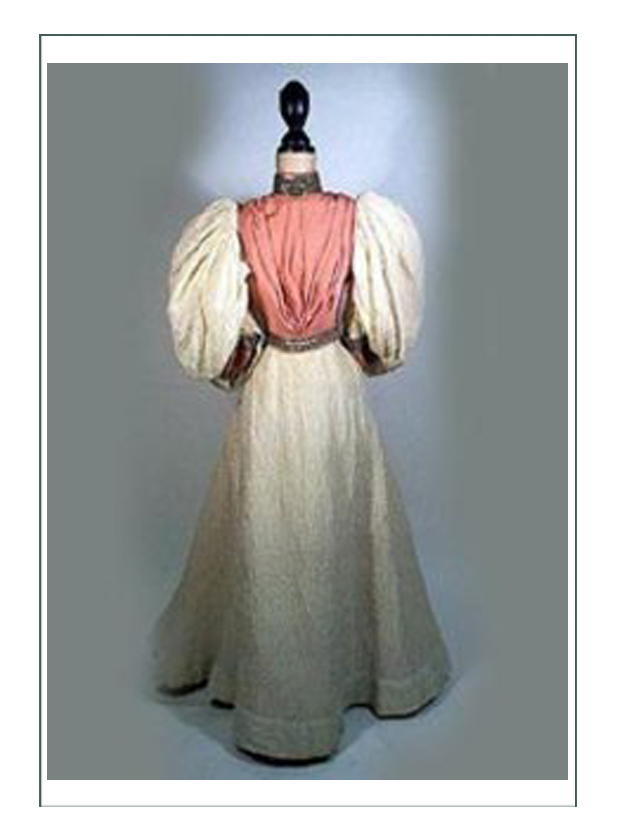
—— (above) “Aesthetic Silk & Faille Gown 1896” ——
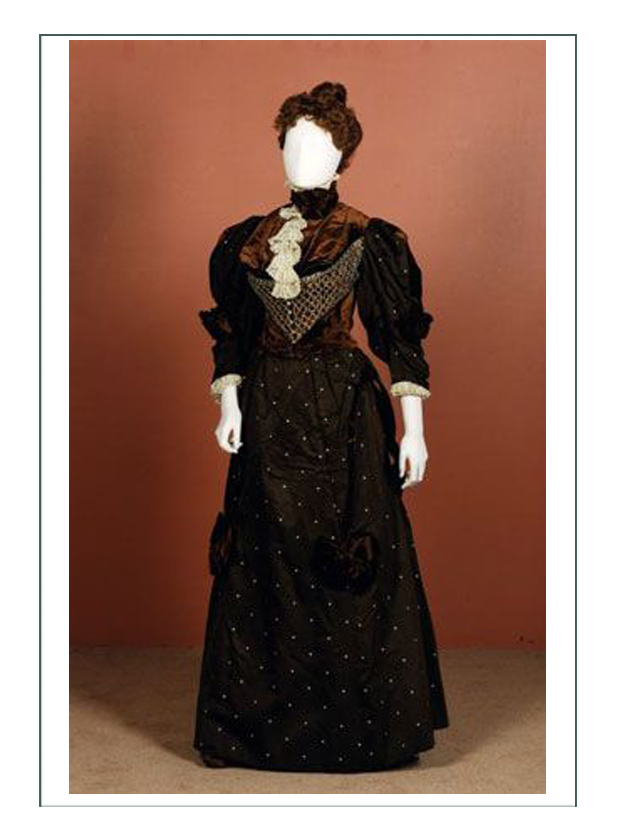
—— (above) “Dinner Gown 1896” ——
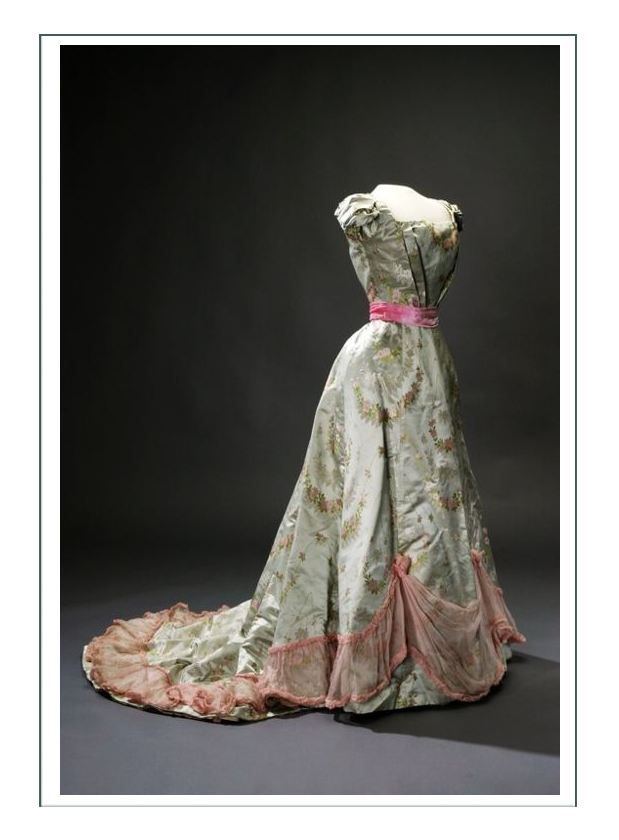
—— (above) “Evening Gown by Worth 1896” ——
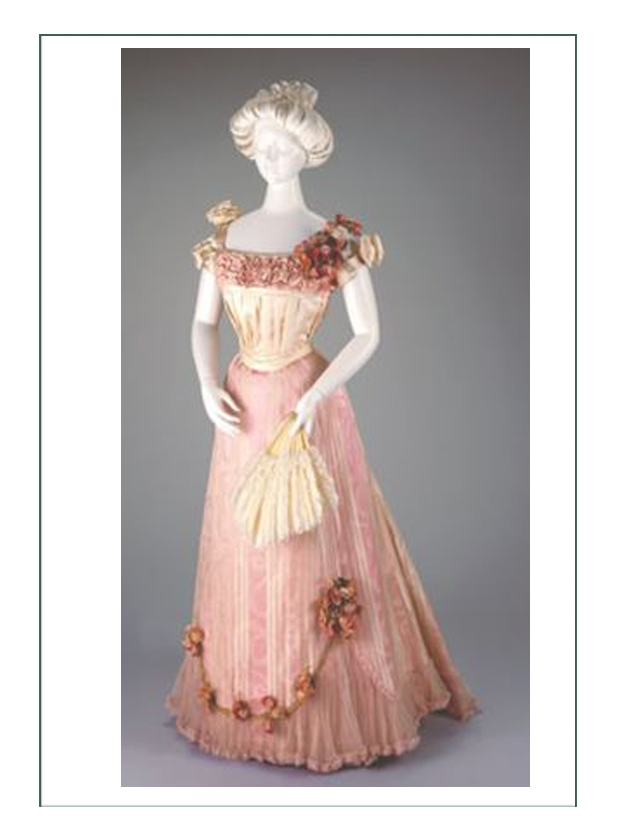
—— (above) “American made Ball Gown 1898” ——
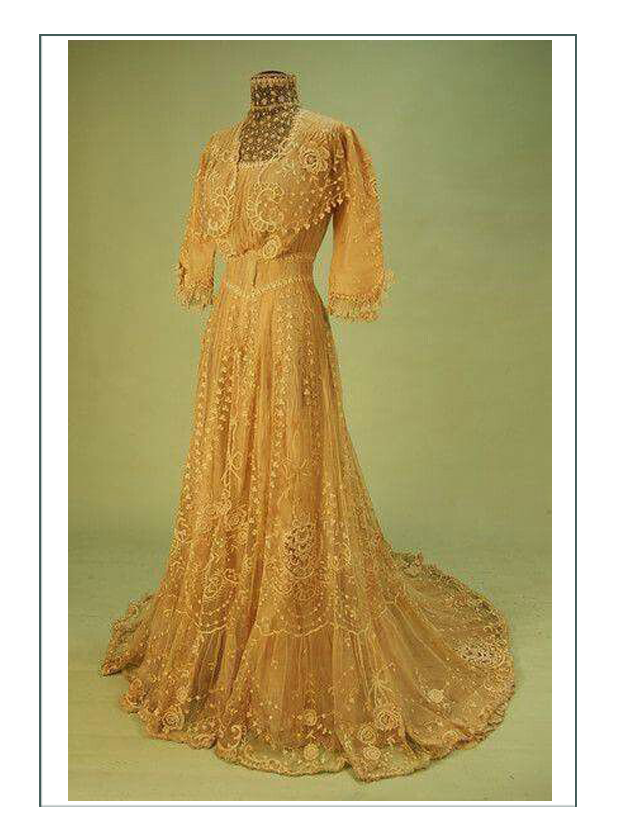
—— (above) “French Tea Dress 1898” ——
Click date below to go to a different era. We can replicate most ANY garment you see!
